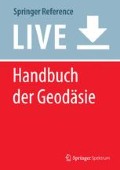Zusammenfassung
Schrägluftaufnahmen erlauben eine gute Sichtbarkeit von lateralen Gebäudeteilen, Bäumen und anderen Objekten. Bei den meisten Prozessierungs- und Auswerteschritten kann auf bestehende Verfahren zurückgegriffen werden, jedoch sollte die besondere Aufnahmegeometrie berücksichtigt werden. Hier ist der stark variierende Maßstab in den einzelnen Bildern und die Verdeckungsproblematik zu nennen. Die großflächige Sichtbarkeit von Gebäudefassaden eröffnet neue Möglichkeiten und Herausforderungen bei der automatischen Bildinterpretation. Diese Aspekte werden in diesem Kapitel ebenso beleuchtet wie die grundlegende photogrammetrische Prozessierungskette und Standardanwendungen für Schrägluftaufnahmen.
Dieser Beitrag ist Teil des Handbuchs der Geodäsie, Band „Photogrammetrie und Fernerkundung“, herausgegeben von Christian Heipke, Hannover.
Literatur
Becker, S.: Automatische Ableitung und Anwendung von Regeln für die Rekonstruktion von Fassaden aus heterogenen Sensordaten. Dissertation Universität Stuttgart, S. 158 (2010)
Englert, R., Gülch, E.: One-eye stereo system for the acquisition of complex 3D building descriptions. GIS 9(4), 16–20 (1996)
Gerke, M.: Dense matching in high resolution oblique airborne images. In: ISPRS – International Archives of the Photogrammetry, Remote Sensing and Spatial Information Sciences, Band XXXVIII-3,W4, S. 77–82 (2009)
Gerke, M., Kerle, N.: Automatic structural seismic damage assessment with airborne oblique pictometry imagery. Photogramm. Eng. Remote Sens. 77(9), 885–898 (2011)
Gerke, M., Xiao, J.: Fusion of airborne laserscanning point clouds and images for supervised and unsupervised scene classification. ISPRS J. Photogramm. Remote Sens. 87, 78–92 (2014)
Haala, N., Rothermel, M., Cavegn, S.: Extracting 3D urban models from oblique aerial images. In: IEEE Joint Urban Remote Sensing Event (JURSE), Lausanne, 5S (2015)
Höhle, J.: Photogrammetric measurements in oblique aerial images. Photogramm. Fernerkund. Geoinf. 2008(1), 7–14 (2008)
Lemmens, M.: Digital oblique aerial cameras (1). GIM Int. 28(4), 20–25 (2014)
Lemmens, M.: Digital oblique aerial cameras (2). GIM Int. 28(5), 20–25 (2014)
Lowe, D.G.: Distinctive image features from scale-invariant keypoints. Int. J. Comput. Vis. 60(2), 91–110 (2004)
Morel, J.-M., Yu, G.: ASIFT: a new framework for fully affine invariant image comparison. SIAM J. Imaging Sci. 2(2), 438–469 (2009)
Murtiyoso, A., Remondino, F., Rupnik, E., Nex, F., Grussenmeyer, P.: Oblique aerial photography tool for building inspection and damage assessment. In: ISPRS – International Archives of the Photogrammetry, Remote Sensing and Spatial Information Sciences, Band XL-1, S. 309–313 (2014)
Nex, F., Rupnik, E., Remondino, F.: Building footprints extraction from oblique imagery. ISPRS Ann. Photogramm. Remote Sens. Spat. Inf. Sci. II-3/W3, 61–66 (2013)
Nyaruhuma, A.P., Gerke, M., Vosselman, G., Mtalo, E.G.: Verification of 2D building outlines using oblique airborne images. ISPRS J. Photogramm. Remote Sens. 71, 62–75 (2012)
Pajarola, R.: Large scale terrain visualization using the restricted quadtree triangulation. In: IEEE Visualization’ 98, Research Triangle Park, S. 19–26 (1998)
Rau, J.-Y., Jhan, J.-P., Hsu, Y.-C.: Analysis of oblique aerial images for land cover and point cloud classification in an urban environment. IEEE Trans. Geosci. Remote Sens. 53(3), 1304–1319 (2015)
Rothermel, M., Haala, N., Fritsch, D.: Generating oriented pointsets from redundant depth maps using restricted quadtrees. In: ISPRS – International Archives of the Photogrammetry, Remote Sensing and Spatial Information Sciences, Band XL-3, S. 281–287 (2014)
Rupnik, E., Nex, F., Remondino, F.: Oblique multi-camera systems – orientation and dense matching issues. In: ISPRS – International Archives of the Photogrammetry, Remote Sensing and Spatial Information Sciences, Band XL-3/W1, S. 107–114 (2014)
Sturm, P.: Camera models and fundamental concepts used in geometric computer vision. Found. Trends Comput. Graph. Vis. 6(1–2), 1–183 (2010)
Xiao, J., Gerke, M., Vosselman, G.: Building extraction from oblique airborne imagery based on robust facade detection. ISPRS J. Photogramm. Remote Sens. 68, 56–68 (2012)
Yang, X., Qin, Q., Qin, X., Wang, J., Bai, Y., Wang, J., Chen, L.: Facade reconstruction from oblique areal images. In: IEEE International Geoscience and Remote Sensing Symposium (IGARSS), Quebec City, S. 1895–1898 (2014)
Yastikli, N., Jacobsen, K.: Direct sensor orientation for large scale mapping-potential, problems, solutions. Photogramm. Rec. 20(111), 274–284 (2005)
Author information
Authors and Affiliations
Corresponding author
Editor information
Editors and Affiliations
Rights and permissions
Copyright information
© 2015 Springer-Verlag Berlin Heidelberg
About this entry
Cite this entry
Gerke, M., Vosselman, G. (2015). Auswertung von Schrägluftaufnahmen. In: Freeden, W., Rummel, R. (eds) Handbuch der Geodäsie. Springer Reference Naturwissenschaften . Springer Spektrum, Berlin, Heidelberg. https://doi.org/10.1007/978-3-662-46900-2_57-1
Download citation
DOI: https://doi.org/10.1007/978-3-662-46900-2_57-1
Received:
Accepted:
Published:
Publisher Name: Springer Spektrum, Berlin, Heidelberg
Online ISBN: 978-3-662-46900-2
eBook Packages: Springer Referenz Naturwissenschaften

